‘House of the Dragon’ Episode 5 Breakdown: Targaryens and Velaryons, Sitting in a Tree
A spoiler-free deep dive into “We Light the Way,” featuring info on the connections between the Targaryens and Velaryons; Criston Cole’s predicament; the new hand, dragon, and maester; and more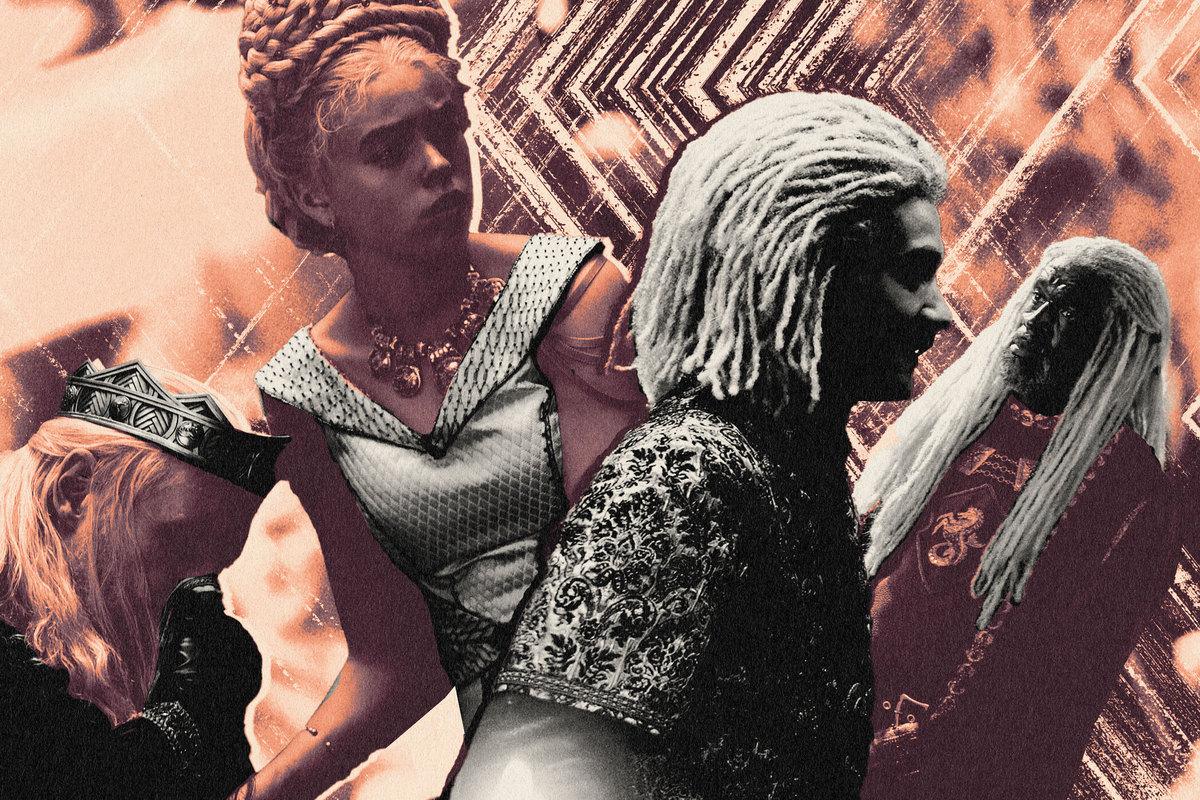
It wouldn’t be a wedding in Westeros without at least one death (though with only one guest dying violently at the nuptials of Rhaenyra and Laenor, the Dothraki would have considered this wedding a dull affair). Episode 5 of House of the Dragon, “We Light the Way,” felt like a midseason finale of sorts, with the various factions that will make up the civil war at the core of this series coming into focus. One of the most powerful players on the chess board is House Velaryon, so it’s time to review what we know about the Targaryens’ closest allies.
Deep Dive: House Velaryon
For a while now, House Velaryon has been buzzing around Westeros’s game of thrones. Corlys began the series on Viserys’s Small Council; the family nearly wed Laena to the king; and Rhaenys shared some advice with the Seven Kingdoms’ new heir. But with Rhaenyra and Laenor now married, House Velaryon is finally playing the game of thrones. And when you play the game of thrones … you know the rest.
When Viserys proposes a marriage between Rhaenyra and Laenor, he tells Corlys that it is “long past time our houses were united in blood.” But this is a bit odd, as the history of House Targaryen and House Velaryon is one of two houses united in blood. (I mean, Rhaenys—who has kept the surname Targaryen—is standing right there!)
House Velaryon has been intertwined with House Targaryen since before Aegon’s Conquest. The Velaryons and Targaryens make up two of the three Valyrian families that survived the Doom of Valyria (along with the lesser House Celtigar of Claw Isle), and so the two have long been close. Aegon the Conqueror’s father was Aerion Targaryen. His mother was Valaena Velaryon. And—you guessed it!—Aerion and Valaena were related. They were cousins, as Velaena had a Velaryon father and Targaryen mother (the names of these two have been lost to history).
While Aegon himself didn’t marry a Velaryon (preferring instead his two sisters), he did enlist Daemon Velaryon as his first master of ships. One of his sons, Corlys (our Corlys’s namesake), served as the first lord commander of the Kingsguard. When Daemon died, his son Aethan took over as master of ships. And when Aegon’s son, Aenys, needed a wife, he married Aethan’s daughter, Alyssa Velaryon.
Aenys and Alyssa had a half dozen children in their 20 years of marriage, one of whom was Jaehaerys—the Old King who was seen in the first moments of House of the Dragon. That makes Jaehaerys more than half Velaryon, for those keeping score at home, and Viserys himself at least an eighth Velaryon from just Alyssa, his closest Velaryon ancestor. Viserys has much more Velaryon blood flowing through him when considering all the other Velaryon ancestors and all the incest in his family tree. Through Alyssa, Viserys has a Velaryon great-great-grandfather (Aethan) and a Velaryon great-great-great-grandfather (Daemon). But he also has a Velaryon great-great-great-grandmother on another branch of his tree, (through King Aenys, Alyssa’s husband) in Valaena Velaryon. Add in that a lot of these half- or quarter-Velaryon Targaryens were marrying siblings who were also half- or quarter-Velaryon, and Viserys still has plenty of Velaryon blood in his veins.
Shoot, Rhaenyra and Laenor are already second cousins because they share great-grandparents in Jaehaerys and his wife Queen Alysanne. And that’s accounting for just their shared relations through Rhaenyra’s father in Viserys and Laenor’s mother in Rhaenys, respectively. Rhaenyra’s mother, Aemma, was also Viserys’s cousin, so Jaehaerys and Alysanne are her great-grandparents through both her mom and her dad, and it’s likely that Laenor has more Targaryen ancestry through his father, Corlys (but since the identities of Corlys’s parents have been lost, we can’t exactly trace it). One could easily argue that these two houses are already way too united in blood. If Rhaenyra understood anything about genetic erosion, she would have hightailed it to Essos with Ser Criston Cole in an instant.
Alas, we have House Targaryen and House Velaryon marrying into each other again. And now instead of looking to the past, it’s time to look to the future. Rhaenyra and Laenor’s marriage is a political one. What does the current House Velaryon bring to the table?
There is one man who has built House Velaryon into what it is on the show, and that man is Corlys Velaryon. As has been mentioned on-screen several times already, House Velaryon makes up the primary naval force at this point in Westerosi history. It controls something like 40 percent of the crown’s ships, and Corlys says that this strength—along with some dragons—means that no one would dare challenge Laenor’s children’s ascent to the Iron Throne. He might be right, but reducing House Velaryon to a bunch of ships would be selling it short. Corlys also brings a wealth of experience to King’s Landing and to Rhaenyra’s brain trust.
Corlys was named after a great-great-grand-uncle who served as Aegon the Conqueror’s very first lord commander of the Kingsguard, but our Corlys surpassed his namesake in fame. In his 20s and 30s, Corlys took to the seas as an adventurer. He started by exploring Westeros, sailing west to Oldtown and Lannisport, and later sailing north of the Wall in an attempt to discover a sea route around the top of the continent. He visited every free city that can be called a port. Soon he started exploring east, from the Summer Isles in the south to the Shivering Sea in the north. Then he passed through the Jade Gates and visited Qarth and Yi Ti, returning with treasures of silk, spice, and jade that made House Velaryon the wealthiest in the realm. He went even farther east on later voyages, passing through Asshai by the Shadow and eventually becoming the first Westerosi to navigate the Thousand Islands and visit Nefer in N’ghai and Mossovy.
During these adventures, Corlys earned the name “the Sea Snake,” and when he married Rhaenys at 37 he was already heralded as the greatest seafarer in Westeros’s history. After his wedding, he intended to settle down and start a family. The dragonriding Rhaenys was a good match for her adventurous husband, telling him on their wedding night that “we can go back to the ends of the earth together. But I’ll get there first, as I’ll be flying.”
Corlys and Rhaenys stuck closer to home over the next couple of decades, having two children in Laenor and Laena. During this time Corlys used the riches he’d acquired as a younger man to construct High Tide, the castle seen in this episode, as a replacement for the grim, wet, and crowded Castle Driftmark. At High Tide, Corlys sits upon the Driftwood Throne, the ancient seat of House Velaryon that legend says was passed to the family by the Merling King, a Poseidon-like deity associated with the Narrow Sea. It is delightfully extra:
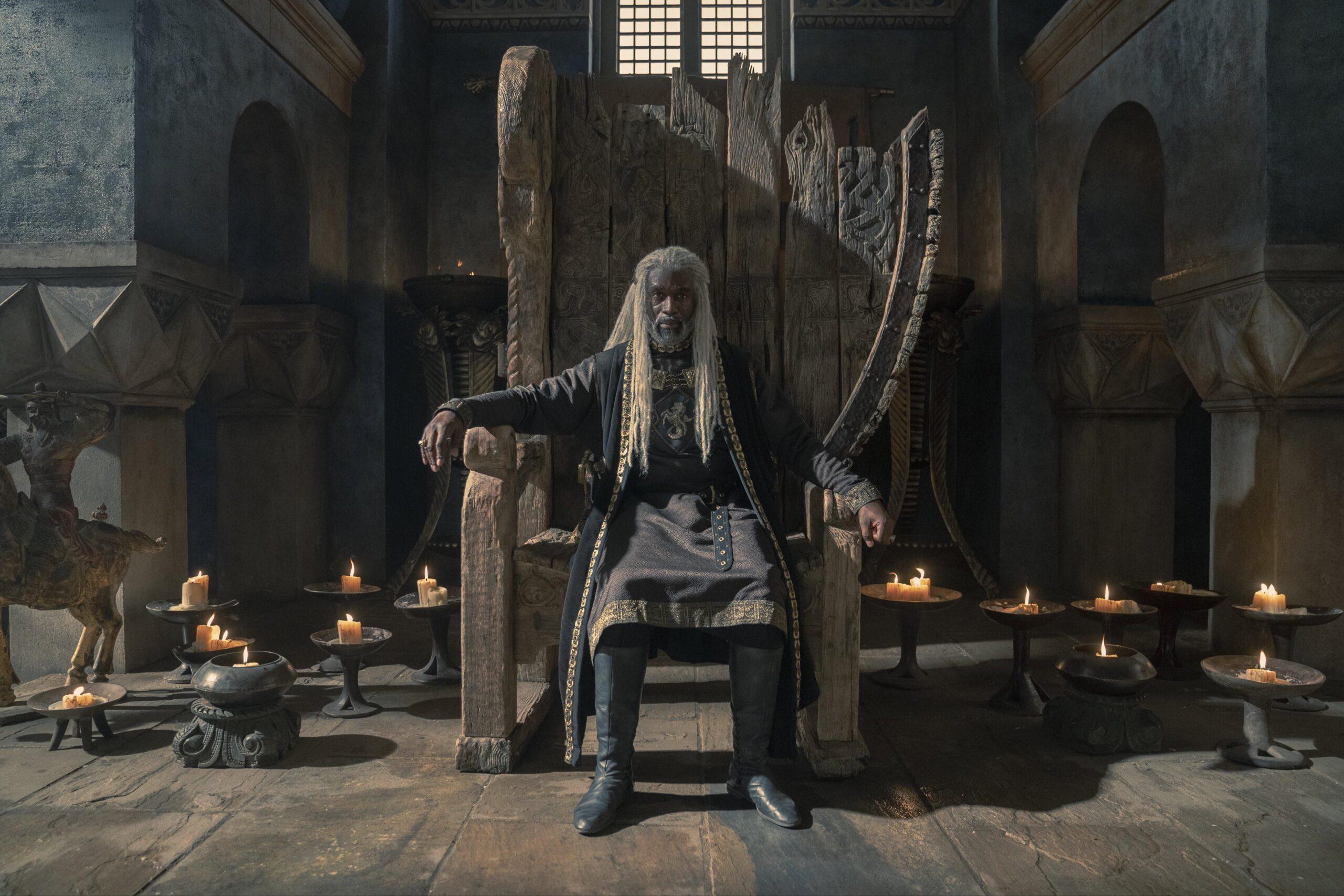
We’re already familiar with the rest of Corlys’s tale. Rhaenys staked a claim to the Iron Throne at the Great Council of 101 AC (After the Conquest), but the lords of Westeros rejected her in favor of Viserys. The king also rejected Corlys’s proposal that Viserys wed Laena. But now, some 15 years after the Great Council, House Velaryon has found a new path to the Iron Throne through the marriage of Laenor and Rhaenyra.
As it stands, it would seem that no one can thwart Corlys’s ambitions. House Velaryon is already the wealthiest house in the Seven Kingdoms, and is second to only the Targaryens in power. In Rhaenyra, Laenor, and Rhaenys, this Velaryon-Targaryen union includes three of the four dragonriders in Westeros. Daemon is the fourth dragonrider, and he’s already shown his, uh, affection for Rhaenyra and a willingness to fight side-by-side with Corlys. Rhaenys knows that “knives will come out,” but what are knives compared to legions of ships and multiple dragons?
If all goes according to plan, Rhaenyra will succeed Viserys, and Corlys’s grandchildren will inherit the throne after her. There are just two problems. One is the well-established issue with women ruling in Westeros. Another is that Laenor may not be too interested in doing what it takes to father trueborn children.
For now, House Velaryon seems to hold all the power, and Corlys appears close to capturing his ultimate treasure. But the ascension of House Velaryon is far from assured.
Quick Hits
RIP, Rhea Royce
We get to know lady Rhea for all of three minutes before Daemon murders her and stages the scene to make her death look like a riding accident—even though Rhea has a reputation as a strong rider. Daemon wants a clean break from the wife he despises, though Rhea’s uncle Gerold won’t let Daemon off the hook easily.
The thing to know about House Royce is that it’s a proud and ancient one. Somewhat like the Blackwoods from last week’s episode, they trace their roots back to the First Men, and they keep the old gods. This is why Daemon refers to Rhea as his “bronze bitch”—it’s because the Royces pass down ancient bronze armor inscribed with runes. That’s also why their seat is called Runestone.
Daemon is now asking to inherit all of Runestone, since Rhea was in line to be the heir and she died without any children. There is no doubt that this won’t go over well. And even if Daemon drops his claim—and he’s probably just looking to provoke, as usual—Gerold doesn’t seem like the type to forget about his niece’s death. The words of House Royce are “We remember.”
RIP, Joffrey Lonmouth
Just as with Loras Tyrell, the Knight of Flowers, or Renly Baratheon and his rainbow guard, George R.R. Martin wasn’t very subtle in pointing out Joffrey Lonmouth’s sexual orientation. “I’m called the Knight of Kisses,” Joffrey tells Ser Criston, “Though I don’t know why.” Really, you don’t?
At any rate, it’s one-and-done for Ser Joffrey, as he overextends in threatening Criston. As a result, Criston bludgeons him to death in front of the entire wedding party. This happens slightly differently in Fire & Blood, where Criston smashes Joffrey’s helmet in during a tourney melee. There at least Criston has some plausible deniability—here it’s unclear what lie he (or, more likely, Alicent) will need to tell to explain his actions.
House Lonmouth is a noble house in the Stormlands, serving House Baratheon, though the Lonmouths aren’t as powerful or notable as the Royces. No other members of House Lonmouth are named in Fire & Blood, though there is a Lonmouth who serves as a squire to Rhaegar Targaryen before Robert’s Rebellion, so this isn’t the end of the Lonmouth line. One would think that the surviving members of the family would ask some questions about why a knight of their house had his head beaten in during a royal wedding … but since in the books Joffrey’s death could be excused as an accident, it was never investigated. I expect the show to do a little yada yadaing here.
The greens and the blacks
As my colleague Zach Kram detailed on Sunday, Alicent showing up late to Rhaenyra’s wedding in a green gown is essentially a declaration of war. Larys and Harwin Strong note that the Hightower of Oldtown—where House Hightower holds its seat—lights a green beacon when calling its banners. Alicent’s striking green gown will earn her side in the upcoming civil war the name “the greens.”
On the other side of the greens we have “the blacks,” which will be Rhaenyra’s faction. The colors of House Targaryen are traditionally black and red, and while Rhaenyra wore white to the wedding, she does have a pitch-black shawl on for the ceremony itself.
This all happens slightly differently in Fire & Blood. In the book, Alicent wears her green gown at a feast to celebrate her five-year anniversary with King Viserys. Rhaenyra, meanwhile, dresses dramatically in Targaryen black and red. Thereafter, those at court mimic the fashion of their chosen leader. People in the “queen’s party” wear her green (which actually isn’t an official color of House Hightower in the books, but appears to have been turned into one for the show), while those in the “princess’s party” wear her black. These eventually just become “the greens” and “the blacks.”
We still have a ways to go before the Dance of the Dragons, but the factions are starting to take shape. If any of the other King’s Landing characters start trending their wardrobes toward green or black in upcoming episodes, it’ll be a strong indication of what side they’ll end up on.
A new hand
Last week I speculated about the candidates for Viserys’s new hand. This week, he made his choice: Lyonel Strong.
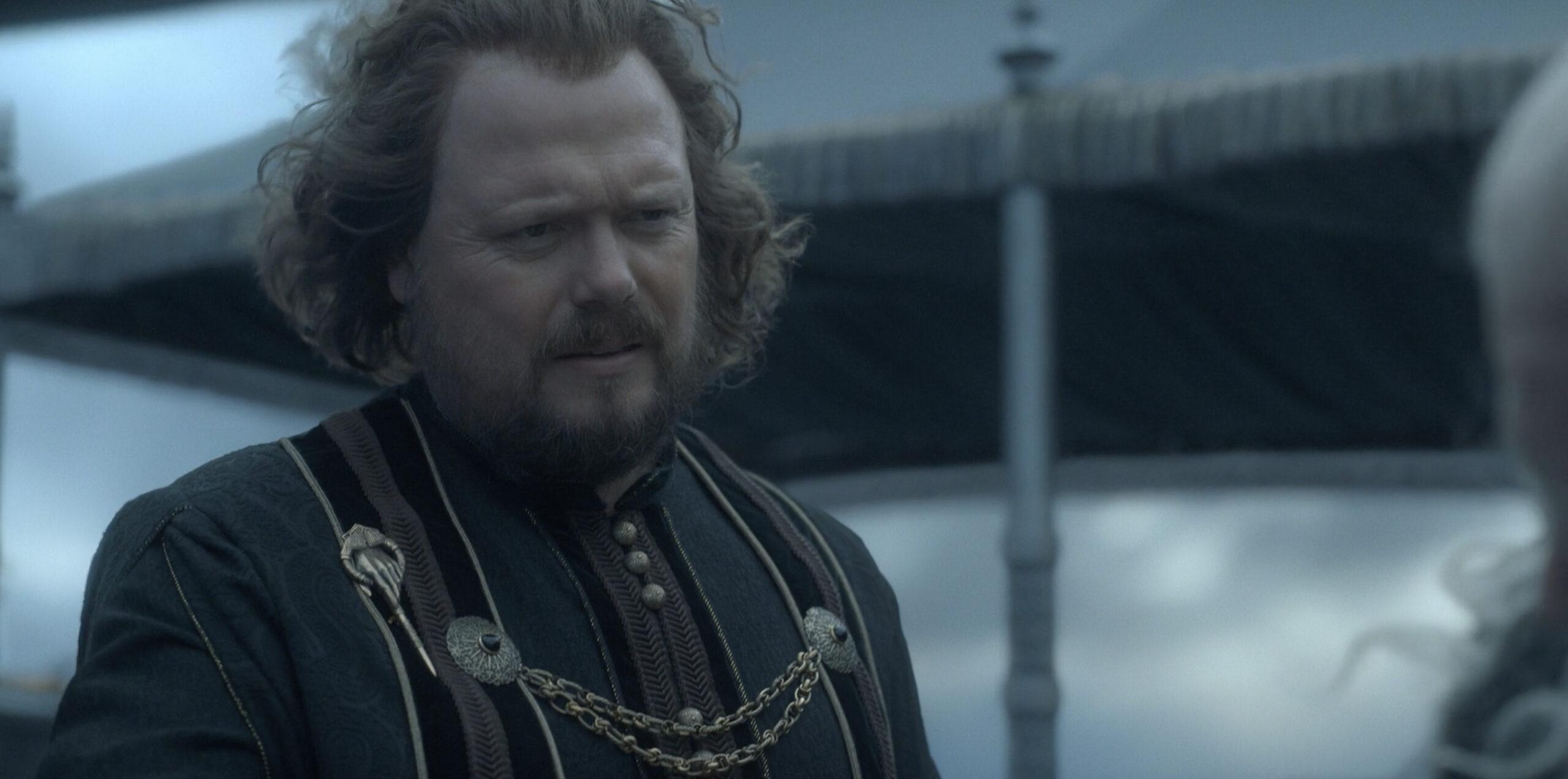
Lyonel did well in advising the king to make a match between Rhaenyra and Laenor Velaryon, rather than put one of his sons—and thus, his own interests—forward. But that doesn’t mean Lyonel has no skin in the game. As his son Larys showed in this episode, the Strongs aren’t above meddling in affairs at King’s Landing.
A new dragon enters the fold
As House Velaryon arrives at King’s Landing for the wedding, we get a glimpse of two dragons:
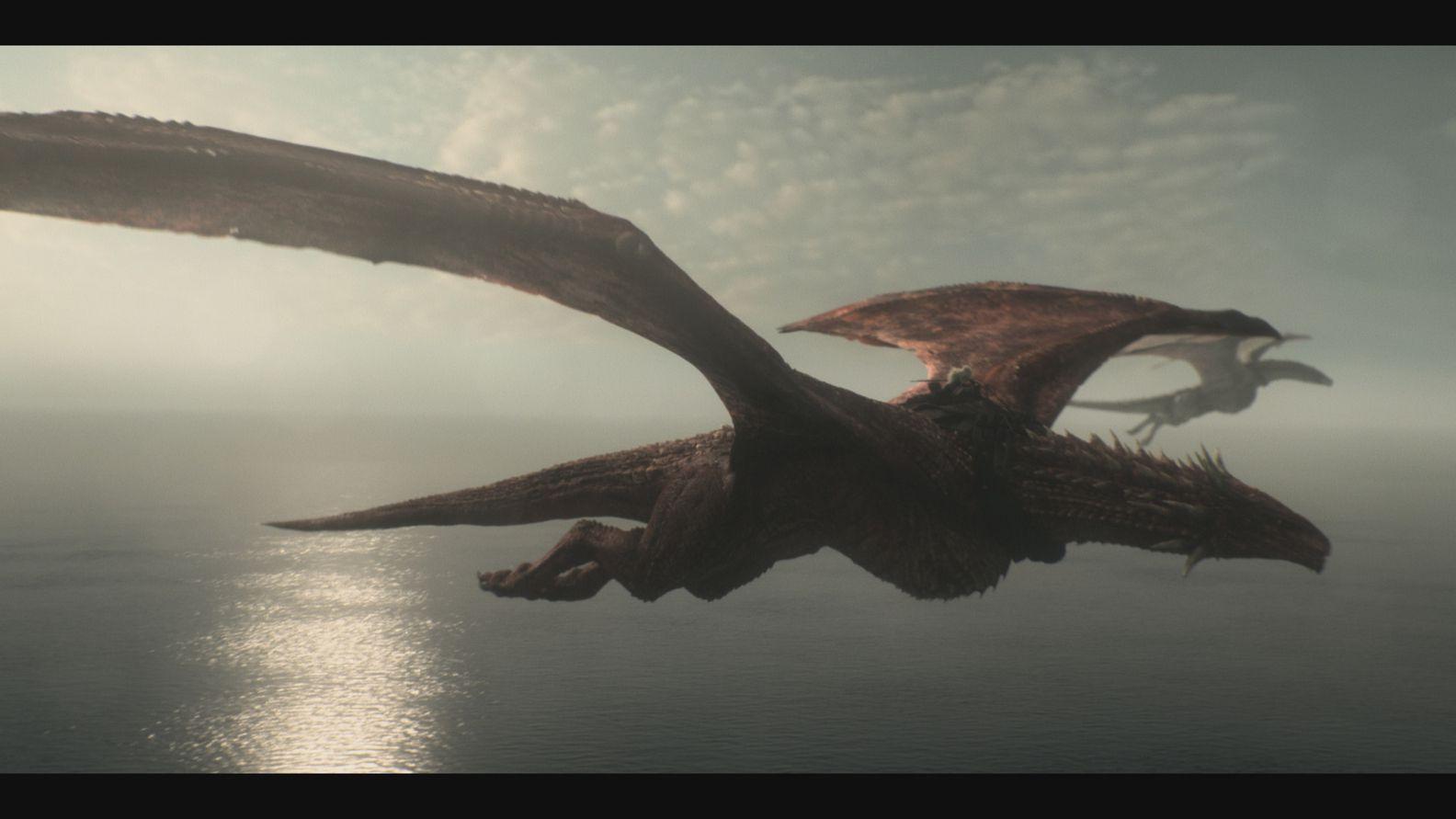
It’s hard to tell for sure, but one of these must be Seasmoke, Laenor’s dragon, which we saw in Episode 3 when the Velaryons were fighting Craghas Crabfeeder. If there’s any time to arrive somewhere on dragonback, it’s for your own wedding.
The other dragon—the red one in the foreground of the above photo—is new. I’m nearly certain that this is Meleys, Rhaenys’s dragon.
Meleys is known as the Red Queen for her scarlet scales and wings, and she was originally ridden by Alyssa Targaryen, Viserys and Daemon’s mother. But Alyssa died in childbirth when Viserys and Daemon were just boys, and a few years later Rhaenys took up her aunt’s former mount. Meleys is described as the swiftest dragon in the Seven Kingdoms—the perfect dragon to match the independent personalities of both Alyssa and Rhaenys.
It’s said that Meleys can be ferocious when roused, though at this point she has no known battle experience. And her reputation is fading a bit, as Fire & Blood tells us that Meleys is growing lazy by the time of the Dance. Whether this is due to age or inactivity is unclear; we know Meleys was a full-grown dragon when Alyssa claimed her in 75 AC, but her actual age has not been revealed.
How much trouble is Criston in for breaking his vows?
Criston is so ashamed of sleeping with Rhaenyra that he suggests to Alicent that he be put to death. But that seems rather dramatic, given the level of promiscuity and just general debauchery in this universe. So how much trouble is Criston in? To answer that, let’s look at the history of the Kingsguard.
Early in Aegon the Conqueror’s reign, he was twice set upon by Dornish cutthroats sent to assassinate him. Both times, his sister-wife Visenya cut down the attackers, and it was decided that Aegon’s existing guards were not up to the task of defending their king. Many of the old kings of Westeros had a champion to defend them, and since Aegon was the king of the Seven Kingdoms, Visenya reasoned that he should have seven champions. Thus, the Kingsguard began to come into form.
Many knights wanted to be a part of this Kingsguard, and Aegon thought to hold a tourney to establish the greatest warriors in the land. But Visenya rejected this idea, saying that knights needed not only skill to defend a king, but loyalty and a sense of duty as well. So Visenya selected seven champions, stripped them of their family colors and draped them in pure white cloaks and armor, and modeled their vows after those of the Night’s Watch. Like their black-cloaked brethren, the knights of the Kingsguard surrendered “all their lands, titles, and worldly goods to live a life of chastity and obedience, with no reward but honor.”
So yeah, chastity is right there in the foundation of the Kingsguard—Criston certainly broke his vows. But what would Criston expect as a punishment if the rest of the court—and in particular, the king—found out about what happened between him and Rhaenyra?
Let’s start with the case of Lucamore Strong, who served in the Kingsguard under Jaehaerys. Lucamore was a great tourney knight, a favorite of the smallfolk in King’s Landing. He had served in the Kingsguard for nearly two decades when it was discovered that he had three secret wives—each unaware of the others—and had fathered a total of 16 children among them.
The lord commander of the Kingsguard at the time recommended that Lucamore be put to death, but instead Jaehaerys had him gelded and exchanged his white cloak for a black one, sending him to the Wall to join the Night’s Watch.
But Criston doesn’t come from a well-regarded family like House Strong, and “deflowering” (to use the vocabulary of A Song of Ice and Fire) the princess and heir to the throne is a bit of a different—and potentially more serious—crime than Lucamore’s. The closest analog to Criston may lie with Ser Braxton Beesbury, a knight who slept with Saera Targaryen, the rebellious and promiscuous daughter of Jahaerys and Alysanne. Jaehaerys was going to have Braxton’s tongue and nose removed, as well as have him gelded and have his arms and legs broken in such a way that they wouldn’t heal properly. But Braxton asked for a trial by combat, and the king slew the knight himself.
Another analogue comes later in the Targaryen dynasty, under King Aegon IV, when a knight of the Kingsguard named Terrence Toyne was found in bed with the king’s mistress, Bethany Bracken. The king had Terrence dismembered limb by limb while Bethany watched, before executing her as well.
So, death is on the table as a punishment for Criston. So is a gelding, and so is a lifelong exile with the Night’s Watch. And Criston can’t count on mercy from Viserys. While the current king is much more reasonable than Aegon IV, known as “the Unworthy,” we’re just an episode removed from Viserys saying he would take the eyes from whoever made the accusations about Rhaenyra and Daemon.
It’s worth clarifying here that the problem for Criston is that he slept with the princess, not that he slept around in general. Plenty of Kingsguard knights break the vow of chastity. The vows to not keep wives or father children are much more serious, but the realm often looks the other way when it comes to casual sex. Many of the white cloaks we see in the main Game of Thrones timeline (including Jaime Lannister, Loras Tyrell, and Meryn Trant) are far from chaste. And the Night’s Watch overlooks its members’ visits to the sex workers in Mole’s Town.
Criston is the rare knight who takes his vows seriously. As he tells Rhaenyra, it’s the only thing he has to his name. What’s most important in understanding Criston is not what breaking his vows would mean to the realm, but what it means to him, and how he’ll act as a consequence.
A new maester appears
As Viserys is getting leeched for the umpteenth time (which seems to be going great), we briefly hear Grand Maester Mellos talking to a Maester Orwyle. Orwyle differs from Mellos in how he would approach the king’s ailing health. Mellos has stuck with leeches (and maggots and who knows what else) to help Viserys, saying that these have always brought the king relief from his ailments. But Orwyle has a preference for potions and tinctures, and before leaving he gives one to Larys to administer to the king. Which of these methods is more effective is hard to tell—it seems that, ultimately, the king’s failing health is beyond the scope of Westerosi medicine.
Orwyle will stick around for a while. In telling his history of the Targaryen dynasty after Robert’s Rebellion, Archmaester Gyldayn (the narrator of Fire & Blood) relied heavily on three sources to chronicle the events of the Dance of the Dragons. One of those sources is Orwyle’s writings, as the maester has an up-close view of events in King’s Landing from here on out. However, as House of the Dragon will likely soon show us, Orwyle is not a purely neutral observer of the Dance, but someone who gets tangled up in the events of the civil war. As such, his writings are considered slanted in his favor.
Mushroom!
Speaking of the primary sources Gyldayn used for Fire & Blood, this week gave us a glimpse at a character who might be Mushroom—a dwarf, court jester, and front-row observer of the politicking in King’s Landing for much of the Dance. He shows up briefly at the wedding:

If Orwyle’s confessions are considered unreliable, The Testimony of Mushroom reads like almost total fiction. His stories are debaucherous, leaning into fantastical tales of sex and violence that likely never took place. He frequently strays from the story to remind readers how big his penis is.
But Mushroom’s account can’t be disregarded out of hand. Many in court wrongly considered him a halfwit, and so he was often present even when high-level plans of treason were being discussed. (Well, he says he was present, at least.) Sometimes his accounts agree with those of Orwyle and septon Eustace (who has yet to appear on the show), lending some veracity to his claims. Other times they differ … wildly.
This may be all we get of Mushroom, if in fact that was Mushroom. He’s a bit of an odd character who I’m not convinced could fit the tone of the show. If that’s the case, it’s still fun to have this nod to book readers.
Family Tree Watch
This episode featured the shortest time jump in the series, with just a few days passing between episodes 4 and 5. As such, there are no real updates to be made to the family tree:
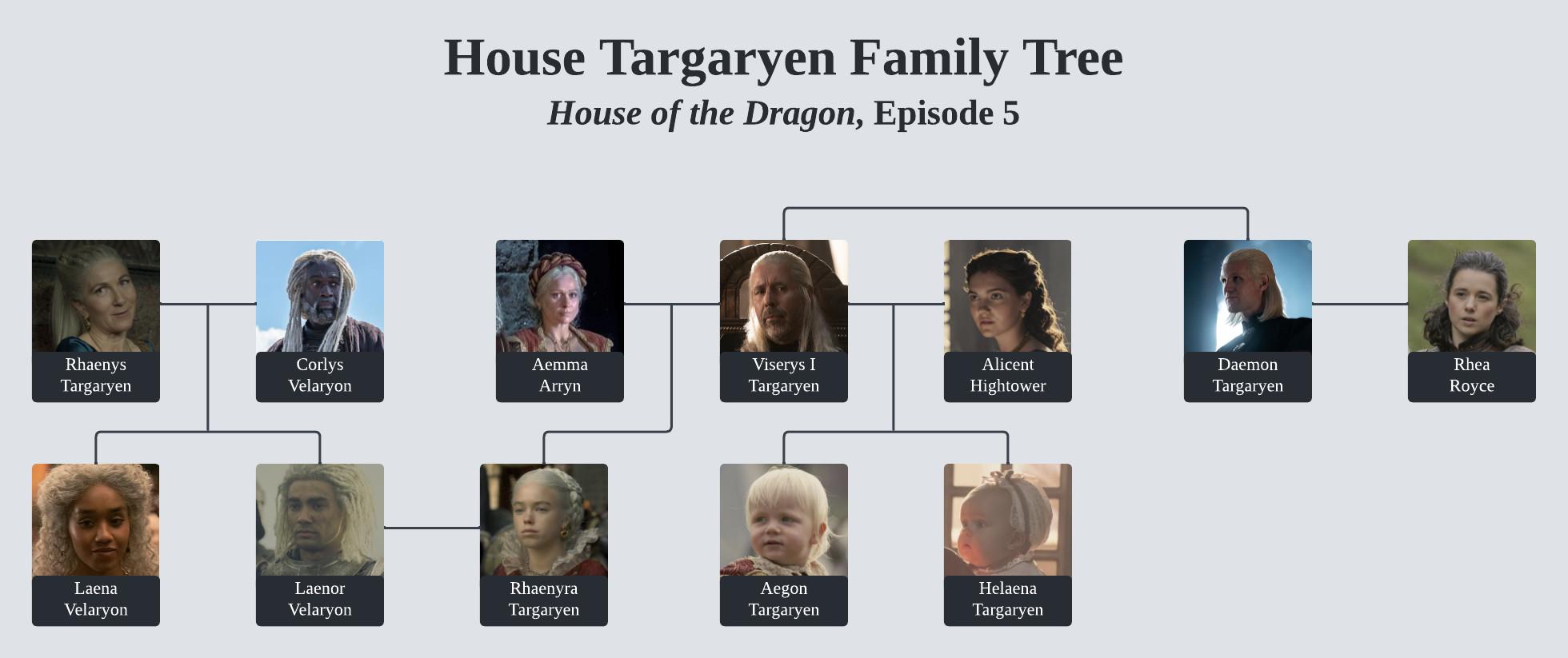
Next Time On …
Welcome to the future:
With the end of Episode 5, House of the Dragon is jumping a decade into the future, swapping out the actors for Alicent and Rhaenyra as the series progresses toward the Dance of the Dragons. Children are growing older, the king is growing weaker, and the cracks in the realm are growing deeper.

